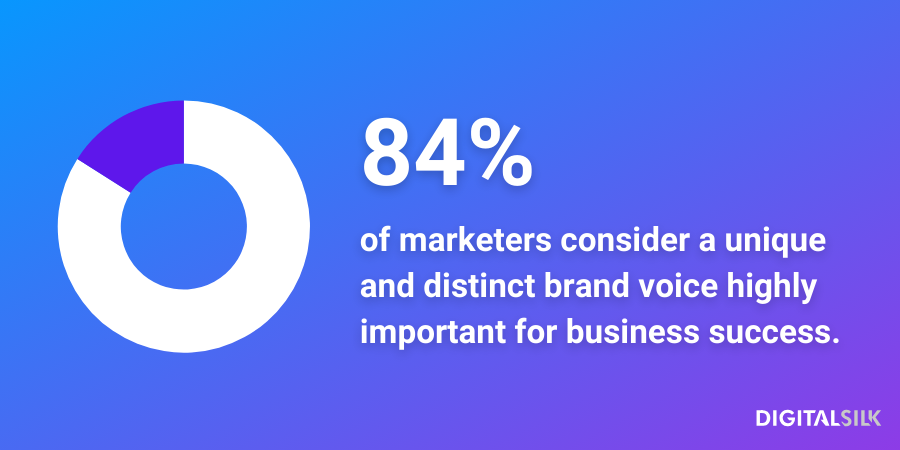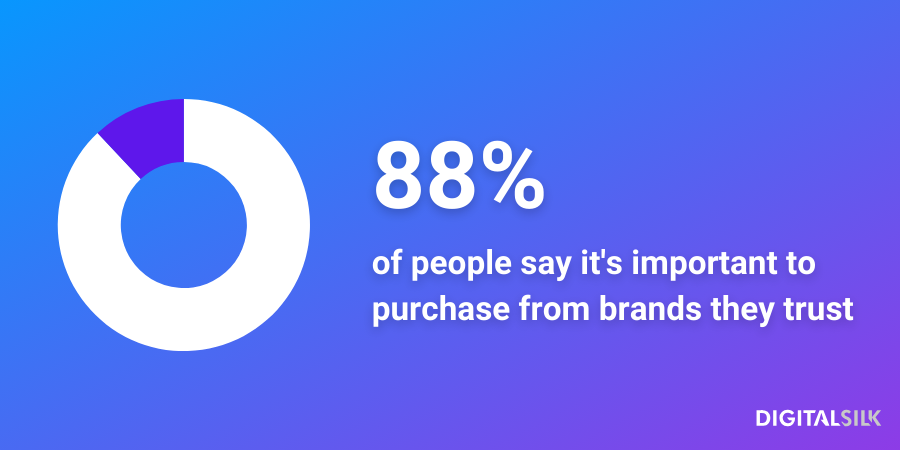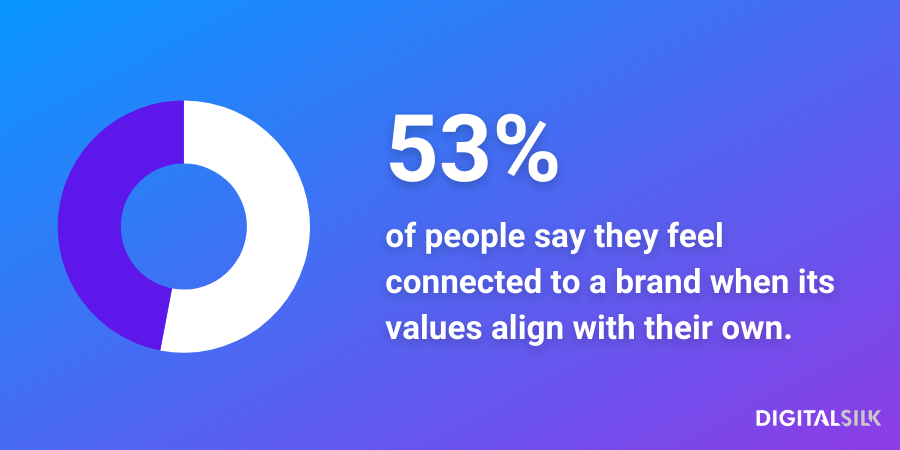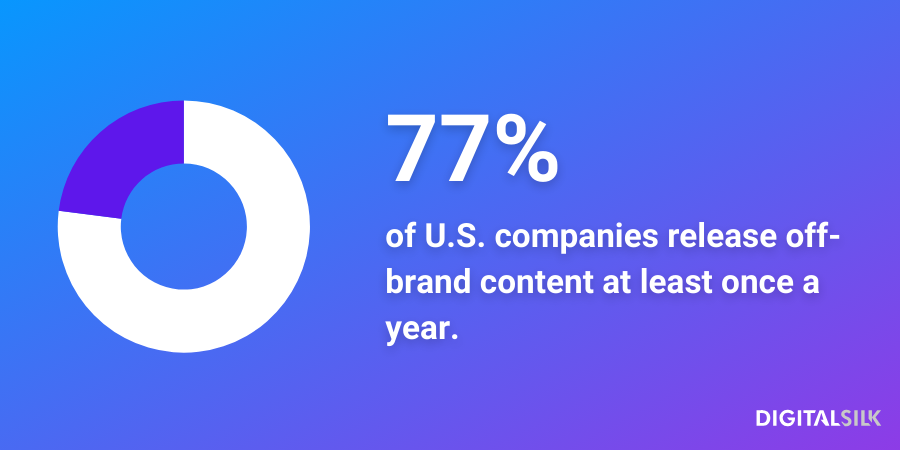Your brand voice is a defining factor in how your business connects with your target audience.
In fact, 90% of senior marketers in the United States (U.S.) believe that brand voice is important to business success.
Just like individual relationships, brands need to act with a consistent, transparent and real voice to build the bridge between themselves and their customers.
To help you create a winning brand voice for your company, we’ve created an extensive guide.
First, we discuss the importance of a brand voice. We then outline seven steps to creating your own brand voice before showing five high-quality examples from brands you know.
[ez-toc]
What Is Brand Voice?
Brand voice is the unique personality your business displays through your lines of communication.
It is impacted by various characteristics, including the tone, language and style you choose to portray your brand.
Think about your favorite brand and how they communicate. Are they inspirational? They might be funny or relatable. Other brands decide to go with professional and reliable brand voice.
Your brand voice plays a central role in connecting your business and consumers in the same way two individuals may become friends — by building a relationship through shared values and personalities.
Defining a unique brand voice can boost brand awareness and nurture loyalty.
But, to be successful, your brand voice must remain consistent across all channels, including:
- Marketing materials
- Social media platforms
- Website and digital content
- Customer service interactions
- Product packaging and labeling
- Offline events and experiences
- Brand slogans and taglines
We’re branding experts. Meet Our Team
Why Is Brand Voice Important?
As a business owner, your brand voice is crucial for connecting with your customers and standing out in a crowded market.
It matters because it:
1. Establishes Your Brand Identity
A unique and distinct brand voice helps set your business apart from your competition. It also creates a memorable identity that customers can connect and identify with.
That’s why 84% of senior U.S. marketing professionals consider a unique and distinct brand voice as highly important for business success.

2. Builds Trust & Credibility
When you communicate authentically and consistently through your brand voice, you’re more likely to earn the trust of your customers.
In fact, 88% of people say it’s important to purchase from brands they trust. Building that trust fosters stronger, more loyal relationships with your audience.

3. Enhances Brand Recognition
A distinct brand voice makes it easier for customers to recognize and remember your business across different platforms and touchpoints.
This increased visibility and recall is valuable, because consumers are more likely to choose from brands they know well.
How To Create A Brand Voice In 7 Steps
Creating a brand voice that matches your brand identity and connects with your target audience can be achieved in seven distinct steps:
Step 1. Research Your Industry Landscape & Competitors
When establishing your brand voice, it’s important to research the industry landscape and analyze your competitors.
You can do this by:
- Identifying your competitors by checking Google, asking ChatGPT or surveying a desired customer segment about which companies they currently use
- Checking the current messaging used across these companies’ social media pages, blog posts and physical brand collateral, as well as the audience reaction to these pieces of content
- Outlining the successful elements of each business’ brand voice and unearthing current gaps in your market that your business can fill
This way, you can establish a unique brand position within your market that also uses the brand voice elements that work best.
At this stage, consider asking questions like:
- What tone and vocabulary are used within the industry?
- Are brands using language that is complex or easy to understand?
- Do you want your brand to fit in or stand out?
Step 2. Analyze Your Target Audience.
To build an authentic connection between your brand and your target audience, you need to understand their common characteristics.
This way, you can craft a brand voice that leans on the shared traits, motivations and backgrounds of your customer segment.
There are two core ways to analyze your target audience:
- Primary research, like surveys and feedback sessions
- Secondary research, such as big data analysis
By combining the responses to your own interviews with wider trend analysis, you can understand the tone of voice and communication channels used by your target audience.
This research should also gather wider background details about your consumers that can help shape the themes you talk about, stance your brand voice takes and language you choose to use.
Some questions to ask include:
- What are your audience’s psychographics; e.g. desires, goals, interests and lifestyle choices
- What do your target audience care about or value?
- What might your audience be hesitant about?
Step 3. Define Your Brand’s Purpose & Essence
To define your brand’s purpose and essence, you need to first identify your brand’s reason for being. This includes the problems you intend to solve and the needs you want to meet.
Your brand purpose should align with the pain points and problems of your target audience and resonate with their feelings, values and experiences.
Fostering a purpose-driven approach can help you establish a meaningful connection that goes beyond just products or services.
According to Sprout Social, 72% of U.S. consumers want brands to contribute positively to society. If your purpose is to reduce environmental waste, for example, your brand is more likely to be emotionally resonant with your target audience.
Articulating your brand’s “why” – the deeper meaning and impact you aim to have – will give your communications authenticity and power.
This purpose should be the foundation upon which you build your brand voice, and can be achieved by:
- Creating a mission statement
- Supporting your words with action from day one
- Ensuring all involved with your business are aligned to, and understand, your purpose
Step 4. Establish Your Brand Values
Brand values are the principles that dictate your brand’s actions and its interactions with your stakeholders, in turn shaping your brand identity.
A strong brand voice requires unwavering brand values.
Think Patagonia and its pledge to environmentalism, or Apple’s focus on innovation and modernization.
By being clear about what you will and will not say or do, you can develop a brand voice that reflects your integrity and builds trust with your audience.
After all, Sprout Social’s research found that 53% of people say they feel connected to a brand when its values align with their own.

The core values that your brand follows should inform every aspect of how you communicate, from the words you choose to the tone you adopt.
To uphold your brand values, make sure to:
- Educate and inform your employees about your values, as they are the biggest representatives of your brand.
- Add your key values to a brand book that all involved in content production can refer to.
- Promote your values through actions as well as language and tone of voice.
Step 5. Attach An Archetype & Personality To Your Brand
Brand archetype refers to the representation of your brand persona in relation to basic human desires or values. In other words, it is the personality of your brand.
Attaching a brand archetype to your company helps to personify the business. In turn, by bringing your brand to life, you can drive individual connections with your audience.
To establish how you want to behave as a brand and build a personality that resonates with your audience, you need to choose a specific brand archetype.
Match your brand archetype with how you wish to be perceived and the values held in the highest regard by your audience, as discovered in step two.
Most brands follow the classic Jungian archetypes, like many great stories and movie characters. These include:
- The Innocent: Embodies purity, simplicity and belief in the world’s goodness. Views life with optimism and childlike wonder.
- The Everyman: Represents the ordinary, down-to-earth person. Relatable and adaptable, focused on connecting with others.
- The Hero: Driven to prove their worth through courageous acts. Seeks to master skills to improve the world.
- The Caregiver: Motivated by a desire to help and nurture others. Values compassion, generosity and creating a sense of security.
- The Explorer: Craves freedom, adventure and new experiences. Driven by a need for autonomy and self-discovery.
- The Rebel: Challenges the status quo and seeks to overturn traditional rules and structures. Driven by a desire for change.
- The Lover: Focused on creating deep, meaningful connections and emotional intimacy. Driven by a need for beauty, sensuality and passion.
- The Creator: Compelled to manifest ideas into reality. Driven by a need for self-expression and to leave a creative legacy.
- The Jester: Embodies humor, playfulness and a lighthearted approach to life. Seeks to entertain and spread joy.
- The Sage: Driven by a quest for knowledge, truth and understanding. Values intelligence, wisdom and sharing insights.
- The Magician: Seeks to understand and harness the fundamental laws of the universe. Driven by a desire to create change and transformation.
- The Ruler: Motivated to assume positions of power and authority. Seeks to provide stability, order and direction for others.
Step 6. Craft Your Brand’s Voice
Having established your brand’s purpose, values and personality, it’s time to put your brand voice into practice.
From tone to grammar and vocabulary, every aspect of your communication content needs to support the brand voice you have defined in the previous steps.
To ensure your brand voice represents the brand archetype and values you have already outlined, make sure to:
- Establish a set of useful and example vocabulary, as well as language dos and don’ts, so that you can speak with conviction and consistency
- Choose the grammatical style to follow to dictate the way you handle spelling, punctuation, lists and dashes, currency and so on. Popular options include The AP Stylebook or The Chicago Manual of Style.
- Use words and visuals within your brand guidelines to set the direction for anyone who will be working with, or on behalf of, your brand.
Step 7. Ensure Consistency
It is important to use your brand voice effectively and consistently. After all, ensuring consistency can boost brand growth by 10-20%.
Not all businesses achieve this. In fact, 77% of U.S. companies release off-brand content at least once a year.

To consistently deliver an on-brand voice to your audience, it’s essential to manage the content produced across all your marketing channels, including:
- Social media
- Website or e-store content
- Brochures
- Sales pitches and marketing campaigns
- Communication points, e.g. customer service lines
Make the guidelines we discussed in steps one to six easily accessible for all involved in content and branding material production. This way, you can ensure that any encounter with your brand matches the tone you want to convey.
We’re branding specialists. Schedule A Consultation
5 Brand Voice Examples From Global Brands
Explore five brand voice examples from top, global brands to inspire your strategy.
Example 1. Ryanair
Brand voice: Witty and irreverent
Ryanair, a budget airline, has cultivated a distinctive brand voice that is mainly displayed across its social media channels.
The brand voice is cheeky and playful, often responding to customer comments or complaints with witty remarks.
By making fun of the services Ryanair provides, like in the post on X shown above, the company reaffirms its brand identity as a cost-saving alternative that shouldn’t be taken too seriously.
Example 2. Slack
Brand voice: Straightforward and efficient

Slack is a cloud-based team communication platform.
It focuses on improving professional workflows and operations. In turn, Slack’s brand voice is direct, straightforward and focused on efficiency.
Rather than trying to be overly clever or humorous, Slack uses simple, concise language to emphasize the practical value of their Software-as-a-Service (SaaS) tool.
This language is shown on the website’s homepage, with messaging like “Made for people. Built for productivity,” setting the tone as soon as a visitor lands on the site.
Example 3. Dove
Brand voice: Empowering and uplifting
Dove is a personal care brand that operates under the Unilever umbrella.
The brand has cultivated a voice that is empowering, uplifting and focused on body positivity.
Its messaging aims to build awareness and inspire confidence, setting the brand apart from more traditional beauty brands.
This is best shown in its famous social experiment-turned-ad shown above.
A group of women had portraits drawn by an FBI-trained forensic artist based on their own descriptions and the descriptions of others. Without fail, the women undervalued their own beauty in comparison to how they were viewed by others.
Dove used this message to support its values of body positivity and drive its uplifting brand voice.
Example 4. Old Spice
Brand voice: Masculine and humorous
Old Spice is a retailer specializing in antiperspirant, deodorant, body wash, hair and beard care for men.
The company’s brand voice is masculine, humorous and exaggerated. It leans into stereotypical notions of masculinity in a tongue-in-cheek way to create a memorable, attention-grabbing persona.
One famous ad, seen above, is titled The Man Your Man Could Smell Like. It addresses female viewers, claiming that anything is possible while their partner smells of Old Spice.
By using an unserious delivery, viewers understand the promises aren’t real but remain captivated by the possibilities enabled by Old Spice’s products.
Example 5. Southwest Airlines
Brand voice: Friendly and personable

Southwest Airlines is a major U.S. airliner providing low-cost flights.
It maintains a brand voice that is friendly, genuine and focused on putting people first. Southwest’s messaging avoids corporate jargon in favor of a more casual, relatable tone that resonates with their broad customer base.
It also favors customer care over themes of luxury or exceptional service offerings.
See the ad shown above, for example. Southwest Airlines released its heart logo in 2014. Stating that the logo was “inspired by our love of people,” the brand reinforces the notion that its audience is central to its decision making.
Create Your Brand Voice With Digital Silk
When executed well, your brand voice can drive a connection between your company and target audience.
However, crafting a successful brand voice that represents your brand identity takes expertise and experience.
At Digital Silk, our branding specialists and senior-level copywriters partner to deliver on-brand messaging across your channels.
In fact, as a full-service digital agency, we manage every element of your brand to deliver cohesive, measurable results across the board.
Some of our core solutions include:
- Digital branding
- Brand strategy
- Custom web design and development
Aside from expert copy and well-planned strategies, we provide three key values to every project:
- We take project ownership
- We give total transparency
- We deliver measurable results
Have a branding project?
Contact our team, call us at (800) 206-9413 or fill out the Request a Quote form below to tell us about your unique project requirements.
"*" indicates required fields








